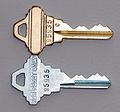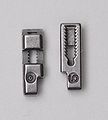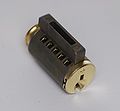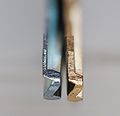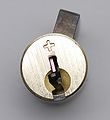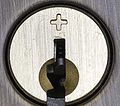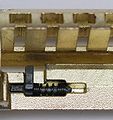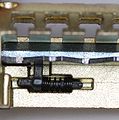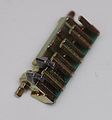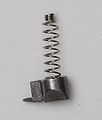Schlage SecureKey
Schlage SecureKey
| Schlage SecureKey | |
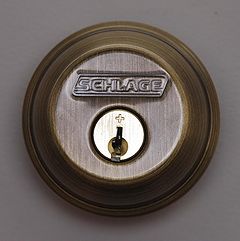 | |
| Name | Schlage SecureKey |
|---|---|
| Manufacturer | Schlage |
| Lock Type | Cylinder |
| Lock Design | Wafer,Hybrid |
| Year(s) Produced | 2010 - Present |
| Patent | US 12/138,950 |
The SecureKey is a user-rekeyable wafer lock made by Schlage. It uses five wafers that interact with a sidebar to provide protection against lockpicking and key bumping. The SecureKey is similar in design, functionality, and name to the Kwikset SmartKey. The rekeying mechanisms of both locks have considerable differences, however.
The SecureKey can be identified by the traditional Schlage C keyway warding and the + above the keyway.
Principles of operation
The SecureKey features five wafers which need to be aligned properly to allow a single sidebar to retract. It is user-rekeyable, meaning that it can be rekeyed by users of the system without disassembly or special skills. This is done through the use of modified "Reset" keys.
Unlike traditional wafer locks, SecureKey wafers are a two part design featuring a guide pin and a wafer. Guide pins are small components that resemble pin-tumblers with a protrusion along one side which connects into each wafer. Guide pins have a concave top which acts as a retainer for a spring in each chamber. Each wafer has one true gate on the sidebar facing side, and ten slots on the opposite side which mate with the protrustions on guide pins. All wafers must be positioned at the same level, but the mating between guide pins and wafers controls how far a given bitting cut on the key will raise each wafer. There are ten bitting positions for each wafer, allowing for a total of 100,000 (105) theoretical key differs. The wafers themselves offer minimal lockpicking protection via a ledge on the top of the wafer which acts as a crude anti-picking mechanism. The design of the cylinder also acts to prevent rotation of the plug when wafers are positioned too high or too low.
The wafers and sidebar are housed in the plug directly, but the guide pins reside in a separate housing in the upper right quadrant of the plug. During the reset procedure this housing physically disconnects from the plug and disengages the guide pins from the wafers but holds the wafers in place at the unlocked position. The blue reset key features a protrusion on the right-hand side which depresses a spring-loaded blocking mechanism in the plug. When this is depressed and the plug is rotated to the 11 o'clock position the guide pin housing disengages, separating the two halves. Once separated, inserting a new reset key and returning the plug back to 12 o'clock re-positions the guide pins and mates them with the wafers at their new position.
In the reset position the keyway is narrowed by the displacement of the guide pin housing. The reset keys have a thinner profile which allows them to be removed and inserted in this position.
Rekeying instructions
In order to rekey the Secure Key you need to have a reset key for the current bitting and the desired bitting.
- Insert the reset key for the current bitting.
- Rotate the plug to the 11 o'clock position. The plug should click into place as the guide pin housing disengages the wafers.
- Remove the reset key and insert the reset key for the desired bitting.
- Rotate the plug back to the 12 o'clock position and remove the reset key.
- Test the new working key.
Notes
- Do not return the plug to the default position without a reset key inserted.
- Do not attempt to reset the key bitting with a blank reset key. Some wafers may not engage the guide pins and the lock will be non-functional.
- If any errors occur you can always completely disassemble and resassemble the lock to return it to a working condition.
- If sufficient variation between adjacent cuts is not present, non-reset keys may be able to be pulled out of the lock at the 11 o'clock and 4 o'clock positions.
Disassembly instructions
- Remove the cam or C-clip.
- Remove the plug from the cylinder. You may have to raise the wafers so they do not block removal of the plug.
- From here the guide pin housing and guide pins can be removed, then the wafers and the guide pin housing spring.
Notes
- Using a working key to position wafers and guide pins is recommended when re-assembling the lock.
- The guide pin housing is difficult to re-assemble if you do not have prior experience with the lock.
Vulnerabilities
The SecureKey may be vulnerable to one or more of the following:
Notes
- The SecureKey cannot be bumped because it does not use pin-tumbler components. (It has been bumped and verified through multiple accounts on Clearstar, including video evidence. Might want to try it for yourself before you let theory write it off.)
- Various decoding and destructive attacks against the Kwikset SmartKey also work against the SecureKey.
Gallery
References
